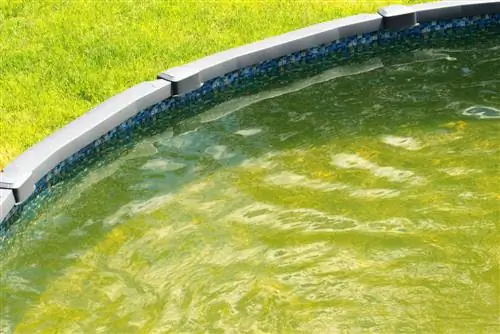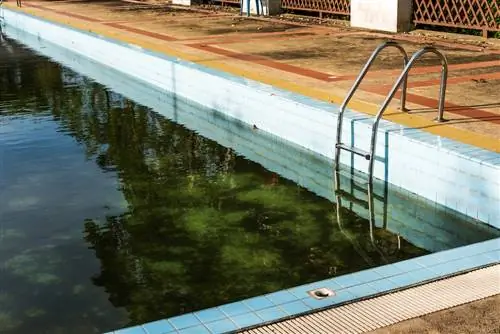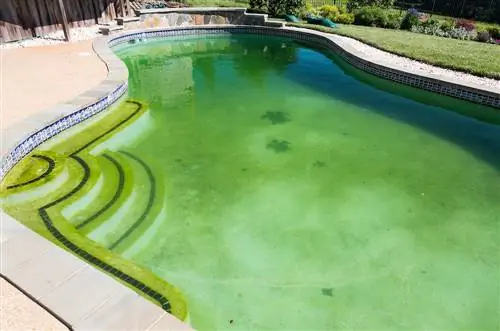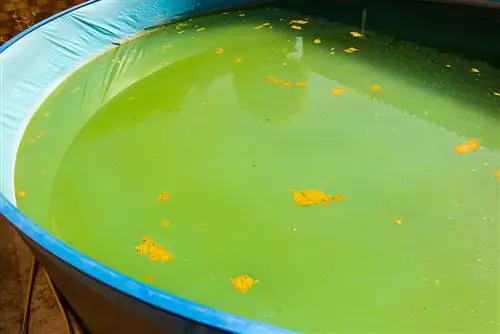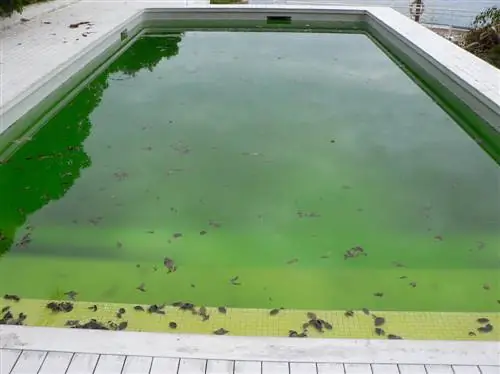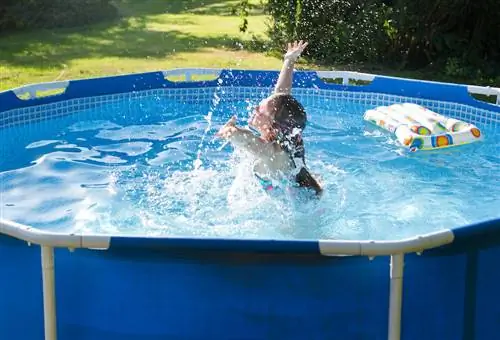- Author admin [email protected].
- Public 2023-12-16 16:46.
- Last modified 2025-01-23 11:22.
They often seem to appear overnight and once in the water they are difficult to remove. Algae colonize the pool when the water parameters are no longer within the normal range. Precautions are important to keep the pool water clean.
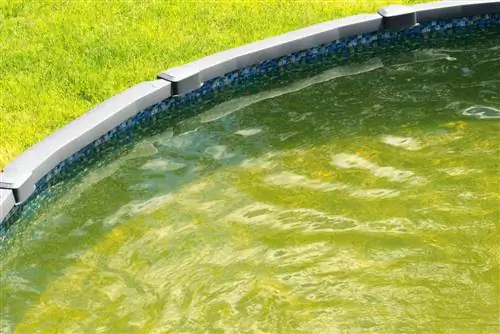
How can I effectively combat and prevent algae in the pool?
To combat algae in the pool, remove coarse dirt, clean walls and floor, check and regulate the pH value and use chlorine, algaecide or other suitable agents. Regular water treatment and covering the pool helps prevent algae growth.
Different types of algae in the pool
Algae are plants that can be unicellular to multicellular. They need sunlight to grow, which is why algae only grow in exposed areas. The organisms are very undemanding and use CO2 and the sun as energy sources to produce carbohydrates and oxygen. There are particularly stubborn algae.
| scientific | Occurrences | Notes | |
|---|---|---|---|
| Red algae | Rhodophyta | Litoral zone of the sea | Bacterial film in pools is incorrectly called red algae |
| Brown algae | Phaeophyta | almost exclusively marine | resistant organisms with a filamentous structure |
| Green algae | Chlorophyta | over 50% of species live in freshwater | form suspended particles or long threads |
| Yellow algae | Xanthophyceae | Freshwater | often referred to as mustard algae |
| Black algae | Cyanobacteria | mainly in freshwater | no algae; rooted in plaster and concrete |
Putative white, red and black algae
If shimmering red or black spots form on the pool walls, algae are usually not responsible. These are bacterial patches that arise from environmental influences and a lack of disinfection. Occasionally, these bacterial collections can also be white in color. The patches detach from the adhesive base and then float in the water. Sometimes deposits that come from outside and settle on the bottom are mistaken for algae.
Cause of algae growth
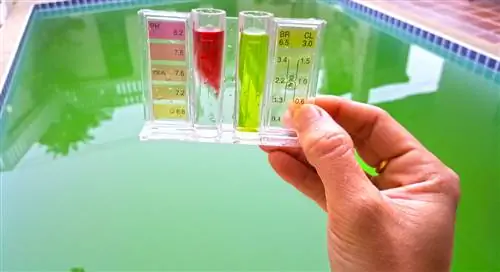
If the pH value is too high, algae growth is encouraged
The pH value and color of the water provide information about the water quality and show which cleaning measures are necessary. Ideally the pH value is 7.4. Algae feel comfortable at higher values. Algae and bacteria are not always responsible for discolored water or deposits on the walls:
- yellow-green water: Indication of increased iron concentration
- milky water: pollution caused by organic residues
- slippery walls: algae growth or bacterial lawn
- rough pool walls: calcification of the water
How do algae form in the pool?
If there is not enough anti-algae in the pool water, the risk of algae growth increases. The pH value also has an influence on algae growth. The organisms need nutrients to grow, which they get from leaves, hair, cosmetics or skin flakes.
Are algae dangerous?
Algae in pools do not pose a he alth risk. Despite the unsightly color of the water, you can swim in the water without hesitation. However, the algae growth should not get out of hand because some species then produce substances that are toxic to humans. This is especially true for cyanobacteria. They produce secondary metabolic products that they do not necessarily need for their actual growth.
Excursus
Algae bloom
Increased temperatures in combination with over-fertilization of the water with phosphate can lead to so-called algae or water blooms. This refers to a sudden and massive proliferation of algae and cyanobacteria. Depending on the species, the water surface turns green, red or blue. The water becomes very cloudy and only a little light reaches the lower layers. Some algae and cyanobacteria produce toxic substances that can be dangerous for bathers. However, there are only about 50 species of algae that develop such toxins.
When does algae form in the pool?
Algae grow where there is little water circulation. Heat and changeable weather as well as residues in the water promote the development of algae. Therefore, algae growth mainly occurs in spring and summer. The most common types of algae in pools are green algae. Brown algae appears as deposits on the pool floor and walls. Yellow algae appear less frequently and develop a powdery precipitate on the ground. Bacteria arise on the walls or floor as a result of a lack of cleaning routine.
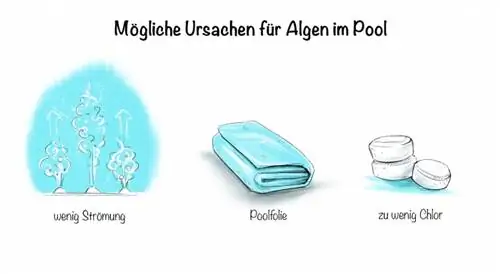
Remove and combat
Successfully combating algae usually requires chemical agents. This pollutes the water and poses he alth risks if the dosage is incorrect. To prevent this from happening in the first place, you should prevent algae growth through proper water treatment.
Basics for proper cleaning:
- remove coarse dirt with a landing net
- Vacuum walls and floors
- mechanical water treatment with pumps and filter systems
- chemical water treatment
- Water exchange with submersible pump
Algae in the pool are not dangerous. However, they indicate an imbalance.
Chlorine
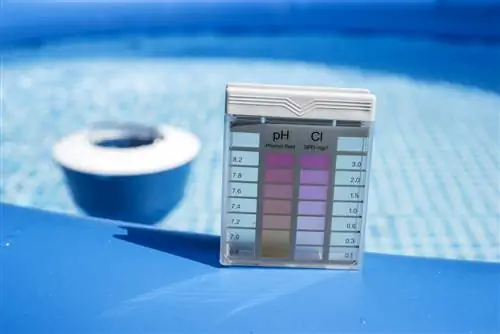
Chlorine protects against algae, but may only be used in moderation
Chlorine is the classic disinfectant in swimming pools. It prevents algae and bacteria from multiplying and kills them. Chlorine can also be used if there is existing algae growth. The concentration should be around three parts per million. If you have algae in your pool despite chlorine, various factors may come into question:
- insufficient water flow
- Foils act as flow brakes
- chlorine concentration too low
Algicide
These biocides are effective against the formation of algae. If used regularly, it can have a preventative effect. If the pool is already infested with algae, these remedies usually no longer help. The organisms multiply despite the algaecide. Many algaecides have high levels of metals, which can cause other problems. If you still want to use these biocides, the products should be free of copper.
Copper sulfate
Copper is an effective agent that stops the growth of most algae. Copper sulfate used to be the main ingredient in algaecides. Today it is only used sporadically. It also kills the extremely resistant black algae on the walls. However, it also comes with disadvantages. Pool water that has been treated with copper sulfate must not be discharged into the sewage system. It must be disposed of properly as the heavy metal is harmful to aquatic organisms.
- Bacteria and viruses are not killed
- Algae can develop resistance
- increased copper content for black spots or yellowish discoloration
Hydrogen peroxide
An alternative to chlorine is water treatment with active oxygen. If hydrogen peroxide is added to the pool water, UV radiation leads to the formation of hydroxyl radicals. These have a much stronger effect than peroxide and ensure the breakdown of organic contaminants. The disadvantages are that the water can quickly become unbalanced. This is especially the case in high season. If chlorine and hydrogen peroxide are used at the same time, the water may become cloudy and a water exchange will be necessary.
Hydrochloric acid
Acids are used to lower the pH value and curb algae growth. Hydrochloric acid is a highly corrosive liquid that should not be used in private pools. Another disadvantage is that chlorides get into the water with the hydrochloric acid. These can promote corrosion.
Inappropriate means
There are some home remedies that should not be put in the pool. Either they are not effective or they do not solve the algae problem. Therefore, think about your methods well in advance and weigh the possible dangers against the advantages.
Vitamin C
Ascorbic acid ensures that the water clouded by algae appears clear again in the short term. This phenomenon is based on a chemical reaction that makes iron particles invisible. However, vitamin C is not able to remove these particles or fight the algae. The basic problem still exists, which is why this home remedy is not suitable for combating algae.

Soda
Washing soda or sodium carbonate can be added to pool water to raise a pH that is too low. About five grams of soda are necessary per 1.00 liters of water to increase the pH value by 0.2 points. However, this measure cannot combat algae growth, as algae prefer to live in water with a pH value above 7.5. Soda should not be confused with baking soda, because it is sodium hydrogen carbonate.
Home remedies for algae in the pool
Cleaning the pool without chemicals is good for your he alth. Since water reacts sensitively to the addition of various agents, the correct dosage is extremely important. The most successful weapon in fighting algae is fresh water. A complete water change makes sense if there is heavy algae growth.
S alt
Many pool owners use table s alt to destroy algae. Slightly s alty water not only has an antiseptic effect, but can also kill freshwater algae. Therefore, s alt plants are used that work with a s alt concentration of 0.4 to 0.7 percent. A dose of table s alt can also be used to combat algae. However, over time the s alt attacks metal objects and in the worst case, all the water has to be replaced.
Vinegar
Just like citric acid, vinegar is a natural agent that can lower the pH value. As oxygen is consumed, acetic acid breaks down and s alts remain. This can kill living creatures in the water if extensive water circulation is ensured. The downside is that vinegar can promote the growth of bacteria.
Tip
In the pharmacy you can buy test strips with which you can test the pH value.
Water treatment
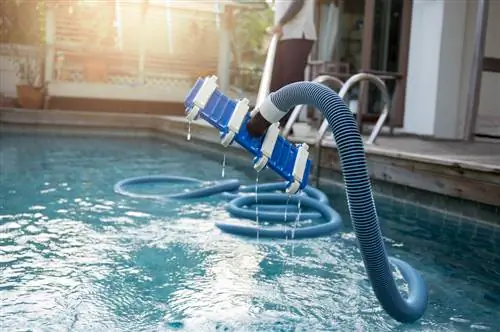
Pool water should be cleaned regularly
To prevent algae from growing in the first place, the water must be cleaned and treated regularly. After the winter season, the pool should be cleaned thoroughly so that no residues affect the water. It is just as important to regularly add fresh water to the pool. The older the water, the higher the risk of algae formation. Since the organisms need light to grow, an opaque tarpaulin is necessary as a cover. Remove corroded items and dead organic material
- pH value should be between 7.0 and 7.4
- Chlorine value is ideally 0.3 to 0.2 milligrams per liter
- Check values weekly
Tip
Before your vacation, you should carry out a chlorine shock to destroy organic compounds and bacteria.
Sand filter
A correctly sized sand filter system cleans the entire pool water using sand with a grain size of 0.5 to 0.8 millimeters. If the water is pumped through the filter system, small suspended particles remain behind and the water enters the pool cleanly.
So that the filter performance is not impaired, the dirt must be backwashed in the drain. The dirt particles are flushed from the filter into the wastewater. This process should be repeated every week to prevent particles from accumulating in the water. The quartz sand should be replaced every two years.
Cartridge filter
These filter systems are an alternative to the sand filter, which are equipped with a paper cartridge. Here too, dirt particles are removed by pumping the pool water through the filter. In order to remove the filtered particles, the cartridge must be sprayed or changed. Leaves, small stones or sand are not filtered out and must be removed with a pool vacuum.
Frequently asked questions
What causes algae to form in the pool?
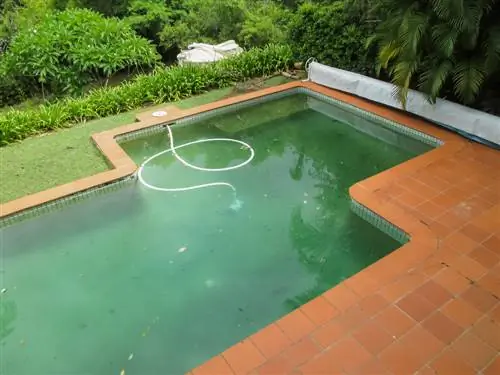
Algae need nutrients, warmth and an increased pH value
Algae are plant organisms that require nutrients, warm temperatures and sunlight to grow. They thrive at higher pH levels above 7.5. When the concentration of disinfectants in the water decreases and environmental conditions are optimal, algae can form overnight in spring and summer.
Algae in the pool and still swim?
Most of the algae that settle in the pool are neither harmful nor toxic nor dangerous. Only a few species of algae develop toxic substances during algae blooms, when they reproduce en masse. The bacteria that are often mistaken for red or black algae are also harmless. You can bathe in the water without any problem. The only danger is the clouding of the water caused by green floating algae. They obstruct visibility when diving.
What helps against algae in the pool?
The floating threads should first be removed with the landing net. Algae and bacterial growth must be removed mechanically from walls and floors as they can sometimes develop entrenched roots. Measure the water values to determine whether they are within the normal range. Shock chlorination proves to be effective in combating algae. If there is heavy growth, a water change is recommended. Also remember to clean all filter systems.
What to do about algae and worms in the pool?
As ambient temperatures rise, algae and small red worms may suddenly grow. Behind the worms are the larvae of mosquitoes, which prefer to lay their eggs on water. These creatures cannot survive if the water is properly disinfected. Chlorination can help. The filter systems should also be checked and cleaned if necessary.
Why do I have dead algae in my pool every day?
Flocculating agents are added to the skimmer as they bind the finest dirt particles. It is added to the skimmer, which should run until completely dissolved. If it is switched off, the agent can flocculate in the water. As a result, structures can form in the water that are reminiscent of white algae. If green algae appears regularly, you should consider a short-term chlorine shock.

